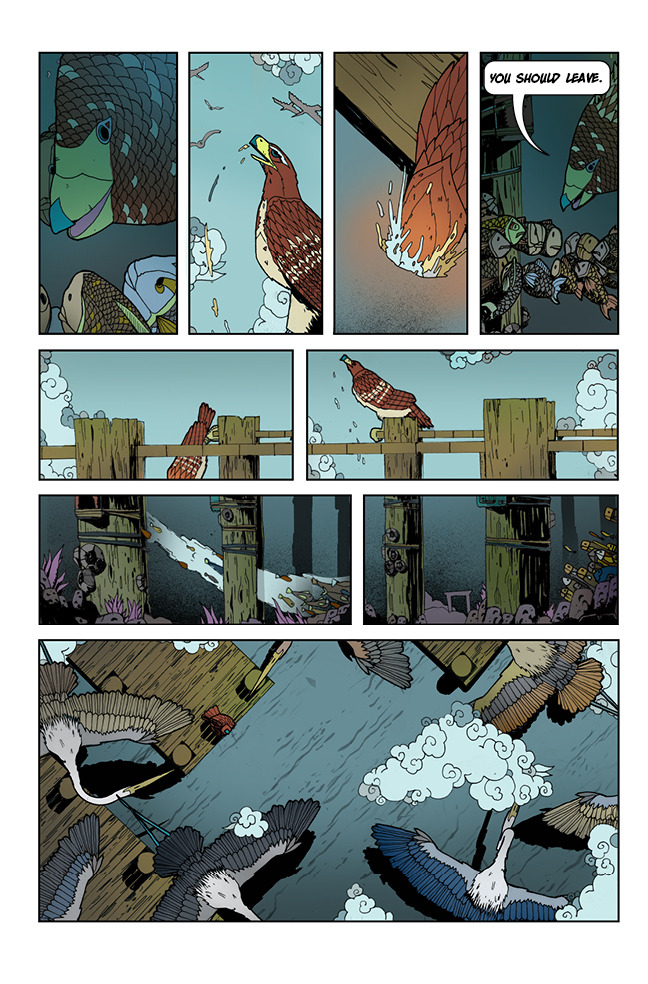In the style of George Orwell’s Animal Farm, The Little Red Fish, the latest project of Richmond-based illustrator
In the style of George Orwell’s Animal Farm, The Little Red Fish, the latest project of Richmond-based illustrator Bizhan Khodabandeh and writer James Moffitt, is a political allegory inspired by the Iranian Revolution of 1979.
The herons are the ruling class, oppressive and self-interested. The fish are the common people, the plebs, if you will, and their champion is the red hawk Manuchehr, who transforms into a fish in water.
“He’s somewhere in-between somebody who’s for the people,” Khodabandeh added. “And of the aristocracy, since he’s a political figure and somewhat removed.”
At times quirky, even funny (in one panel, a merchant-fish sells local-grown organic algae. “No GMOs!” he calls out), The Little Red Fish is nevertheless deftly critical, smart, even courageous in its exploration of a time in history not oft talked about.
“I like comics,”said Khodabandeh about why he chose this art form for such a complex narrative.

Though he’s been reading them since he was a teenager, it wasn’t until after High School, after he discovered the work of graphic novelist Chris Ware (Acme Novelty Library), that Bizhan started thinking differently about what comics could do.
“His work blew me away,” he said, “I didn’t know that comics could be about something other than superheroes.”
It’s no wonder then that the hero and what defines him/her is a major theme of Khodabandeh’s comics. In an apt scene in the second (and latest) issue, Menuchehr leads The Little Red Fish to the orb.
“The orb is… us,” he says. “It’s the will of the people… The power of the orb is great, and will only embrace you when the people deem you worthy of accepting it… Only through their communal good will you become gifted.”
So I asked Khodabandeh: what is a hero? “I love Joseph Campbell’s ideas on the hero,” he said. “At the expense of presenting my superficial understanding of his ideas, he describes a hero as an individual who is changed significantly by metaphorically killing the person they once were to emerge as someone new.”
“In our culture, we tend to throw the term around as if society must validate whether or not someone is a hero. This isn’t something to vote on or that can be pinned down. Heroes come in all shapes and sizes with varying levels of self-sacrifice.”
Moffitt went a step further when explaining his concept of ‘heroism’ and how it isn’t always jumping headfirst into a burning building or throwing yourself on a grenade.
“Sometimes, it’s just the ability to be self-aware, and to do the right thing,” he said. “It’s something that everyone is capable of being.”

“As The Little Red Fish series progresses,” he added, “I think people will begin to see that more.”
I met up with Moffitt in his writing space. Totally laid back, he sat at his desk, sipping from a PBR in a camo-koozie. Still, he intimidated me. He’s smart, well-read, his bookcase is packed with an amalgam of different writing styles and genres: Dave Eggers’s What Is The What beside Hemingway’s The Old Man and the Sea beside a stack of Kirkman’s The Walking Dead.
Out of grad school in 2012, and sick of reading Howard Zinn and Mikhail Bakhtin, Moffitt returned to comics, now with a rhetorician’s critical eye (he studied Writing and Rhetoric at VCU). With Pat at Velocity Comics, he “discovered” dozens of low-profile comics which have since become his personal favorites.
“I realized,” he said, “that these guys were writing stuff that was just as serious as what I had been reading in grad school.”

Are we witness to a new trend in comics, with artists like Marjane Satrapi (Persepolis) and Art Spiegelman (Maus) using the medium to write memoir, or Kirkman with The Walking Dead exploring human nature and social structure in a way that hasn’t been done before.
“I think artists have always been pushing the form,” Moffit said. “We’re just new to this kind of work.”
When I pushed a little further, however, suggesting that the The Little Red Fish is revolutionary in its own way, “pushing the form,” so to speak, James stopped me.
The narrative is what’s most important, he said. If he and Khodabandeh are challenging the conventional comic book and comic book hero, they’re not doing so to the detriment of strong characters and a riveting story.
In the end, James said, “we want to tell a great story.”
The Little Red Fish is available now through RVA’s own Sink/Swim Press here, or at fine book and comic book retailers.


